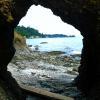February 6, 2015 - 23:32

When I initially sat down at my spot, I knew I would need my gloves. Because of the freezing temperature, I curled up on the side of the tree that would block me from the chilling wind, instead of taking in the view. I didn’t have any idea of what I wanted to look at or experience, but, as is probably most natural for me as a geologist, I was barely within arm’s reach of the ground before I was already reaching for a rock.
Loose rocks of varying shape, color, texture littered the roots along with organic leaves and twigs, and they seemed the most likely to entertain me for a while. I reached for the first rock that caught my eye—a sparkling piece of schist—only to discover that it would not budge. At first I assumed that was because it was partially buried in the ground. I could have left it be, but again, the “nose-to-the-rock” geologist wanted a closer look. A little more force and determination on my part freed it. The fuzzy, white decoration on the ground side of it, like mold, told me that it had pretty much been frozen to the dirt. My first reaction was simple: what? I don't think I've ever gone to pick something up to find the ground reluctant to let it go. An actual scientific explanation aside, to me it felt like the ground hadn’t wanted to yield up that rock. It had preemptively determined that those rocks were to stay scattered in their perfectly random natural state.
I pried it up anyway, because it was late on a Friday, and I didn’t really feel like getting into a turf war with nature. Besides, what is a natural state? Those pieces of rock, fragments of formations, had been broken and scattered so far from their original locations, that the line between original and removed was far beyond blurry. The schist and gneiss I picked up we humans had dug out of the earth from nearby quarries or as far away as Baltimore and transported to build our buildings, leaving pieces of it scattered around the grounds. But how is that displacement any more or less natural than the smoothed conglomerate pebble? The rounded nature of the pebble tells me that it probably had travelled far to end up under that beech tree, as had the pebbles making up the conglomerate that it itself was a pebble of. (Pebble-ception, we could call it.) And then there was the large, porous chunk of reddish clay-like material. It was eerily similar to a heavily weathered, man-made brick, but still I couldn’t make up my mind over what it was, or who or what had brought it here.
